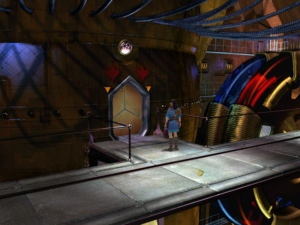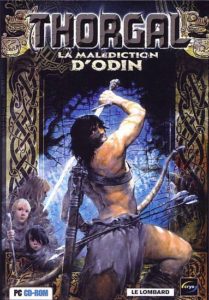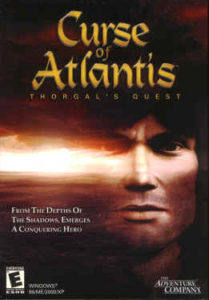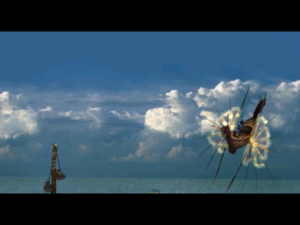IFComp 2007: Lost Pig
Lost Pig concerns an orc named Grunk, familiar to some parts of the IF community for his Livejournal. Spoilers follow the break.
Lost Pig concerns an orc named Grunk, familiar to some parts of the IF community for his Livejournal. Spoilers follow the break.
A game written in Adrift by someone using the pseudonym “revgiblet”. (The game data contains what might be revgiblet’s real name, but I won’t state it here.) The premise: you’re Death. Spoilers follow the break.
Still trying to get caught up in these posts. Next up is a piece by newcomer Nestor I. McNaugh, concerning an arrogant gentleman thief in a modern setting. (It actually took me a while to realize that it wasn’t a fantasy setting, as the first element of the setting you hear about is a Thieves’ Guild.) Spoilers follow the break.
So, now that the rules of the Interactive Fiction Competition allow blogging about comp games during the judging period, let’s get started. Choosing my first game at random, I got Ghost of the Fireflies by Paul Allen Panks. This did not bode well. Spoilers follow the break.
Read more »
I think most of the people who read this blog are already aware of this, but: the judging period of the 13th Annual Interactive Fiction Competition is now open, and lasts until November 15. You can be a judge, and if you’ve never judged the comp before, I encourage you to give it a whirl. There are 29 entries this year, expected to vary from brilliant to abysmal. This is the smallest batch since 1998, so if you’ve found previous comps daunting, here’s your chance. 29 may still sound like a lot of games to play, but they tend to be short — judges are asked to judge each game after no more than two hours of play, finished or not, and the competitors know this.
Me, I’ll be devoting a large portion of my gaming hours to this for a while, and not blogging about it until the judging period is over, as that would be against the rules. So I don’t know how much I’ll be posting during that time. Maybe I’ll make another go at Pokémon between comp games or something.
[UPDATE 3 October 2007] Correction to the above: the rule against discussing games in a public forum before the judging period is over has been relaxed somewhat this year. Judges are now allowed to publish discussion of the entries as long as they “[m]ake appropriate allowances to hide spoilers, and don’t put spoilers in titles of posts or blog entries.” Now that I know this, I shall do so.
 I mentioned before that I own three games that are based on French comic books, but this turns out not to be true. Rather, I own one game based on a French comic book (Druillet’s Salammbo), and two games based on Belgian comic books. No coincidence, either: the same artist provided the source material for both. One of them, XIII, has been off the Stack for some time. The other, Thorgal’s Quest, really should have been finished long ago too — it’s essentially a one-sitting game — but I took a break in the middle, and by the time I got back to it I had activated the nVidia glitch and made the game unplayable. (Even with my new graphics card, there are occasional video problems and even crashes, but nothing that couldn’t be overcome by saving regularly.)
I mentioned before that I own three games that are based on French comic books, but this turns out not to be true. Rather, I own one game based on a French comic book (Druillet’s Salammbo), and two games based on Belgian comic books. No coincidence, either: the same artist provided the source material for both. One of them, XIII, has been off the Stack for some time. The other, Thorgal’s Quest, really should have been finished long ago too — it’s essentially a one-sitting game — but I took a break in the middle, and by the time I got back to it I had activated the nVidia glitch and made the game unplayable. (Even with my new graphics card, there are occasional video problems and even crashes, but nothing that couldn’t be overcome by saving regularly.)

 Thorgal’s Quest seems to have been a straight-to-bargain-bin release. I picked it up mainly because the packaging was designed to fool you (successfully, in my case!) into thinking it was part of Cryo’s Altantis series. Apparently the original title is Thorgal: La Malediction d’Odin, but the North American release is Curse of Atlantis: Thorgal’s Quest, with “Atlantis” in much larger letters than “Thorgal”. (I’m calling it Thorgal’s Quest here to split the difference.) It just shows how provincial fame is. According to Wikipedia, Thorgal is “one of the most popular French language comics”, and a best-seller as recently as 2006, but over here, it’s so unknown that a tenuous connection to a semi-obscure adventure game series gets top billing. 1 See also the 1983 laserdisc game Cliff Hanger. No way would that get released today without the name “Lupin III” plastered all over it, and probably “Hayao Miyazaki” as well.
Thorgal’s Quest seems to have been a straight-to-bargain-bin release. I picked it up mainly because the packaging was designed to fool you (successfully, in my case!) into thinking it was part of Cryo’s Altantis series. Apparently the original title is Thorgal: La Malediction d’Odin, but the North American release is Curse of Atlantis: Thorgal’s Quest, with “Atlantis” in much larger letters than “Thorgal”. (I’m calling it Thorgal’s Quest here to split the difference.) It just shows how provincial fame is. According to Wikipedia, Thorgal is “one of the most popular French language comics”, and a best-seller as recently as 2006, but over here, it’s so unknown that a tenuous connection to a semi-obscure adventure game series gets top billing. 1 See also the 1983 laserdisc game Cliff Hanger. No way would that get released today without the name “Lupin III” plastered all over it, and probably “Hayao Miyazaki” as well.
The Atlantis games are first-person adventures based mainly around gratuitous self-contained puzzles slapped arbitrarily on various ancient-civilization backdrops — not the sort of thing I’d easily recommend to others, but sometimes I’m in the mood for it. For example, I was in the mood for it when I bought Thorgal’s Quest, which instead turned out to be a third-person adventure game based mainly around hunting for small objects and occasional archery mini-games.
Thorgal is a Viking warrior who, in the cutscenes, looks kind of like Mick Jagger wearing a tunic and a prominent facial scar. The game starts out with him doing the Odysseus thing, stranded far from home and family by a storm at sea brought on by the wrath of the gods. Enter a magician who shows him a harrowing vision of the future: Thorgal shooting and killing his own son. Thorgal immediately decides that the vision must really be about a shape-shifting villain adopting his guise, and rushes to get home and protect his son before it’s too late, making gamers everywhere shake their heads sadly.
On the way to the lee of the island, where he hopes he can hire a boat despite the storm, Thorgal has an adventure involving some canny bandits who keep the villagers cowed with a fake dragon. Then he almost drowns, only to be whisked away by the same magician to a place called Between Two Worlds, which is your basic Ethereal Void with floating rocks and everything. It was at this point that I really started to suspect that the game was based on a comic book, especially when I met the Guardian of the Keys. Partly it was her apparent role as some kind of cosmic keeper of the balance. Partly it was her appearance: a sexy woman with vivid magenta skin wearing basically nothing but strategically-placed locks of hair. But mainly it was the way that Thorgal already knew her from previous adventures. You could practically see the captions referencing back issue numbers.
Before the Guardian of the Keys can send Thorgal back home, he has to pass a trial involving an interactive representation of his past. And it is here that I learned of his extraterrestrial heritage.
Seriously, now, this has got to seem less bizarre to a player who’s familiar with the source material. It makes me wonder how certain other adaptations I’ve played must seem to outsiders.
 It’s also at this point that the Atlantis material creeps in and provides Cryo an excuse to re-use their Altantean skyboat model. Thorgal’s spacefaring parents, it seems, are descendants of people who fled dying Atlantis for the stars centuries ago. Based on what I’ve seen online, I’m not at all convinced that this is canon. It might just be Cryo winking at the fans, much like the Sam and Max cameos in the old Lucasarts games.
It’s also at this point that the Atlantis material creeps in and provides Cryo an excuse to re-use their Altantean skyboat model. Thorgal’s spacefaring parents, it seems, are descendants of people who fled dying Atlantis for the stars centuries ago. Based on what I’ve seen online, I’m not at all convinced that this is canon. It might just be Cryo winking at the fans, much like the Sam and Max cameos in the old Lucasarts games.
I won’t say much more about the story — Thorgal does get home, and the prophecy does come true but not in the manner anticipated, just like you’d expect. All in all, the production is a bit amateurish. There’s some very nice art in the backdrops, but there are also places where the hand-drawn bits are too visible and don’t mesh with the 3-D models well. The story is completely linear, even in some cases blocking actions for no logical reason until you’ve clicked on an NPC often enough to get all his scripted dialogue (even if the last bit is just “Farewell and good luck, Thorgal” or something.) It’s far from the worst adventure game I’ve played, but it’s clearly built for Thorgal fans, who are expected to be a little forgiving.
| ↑1 | See also the 1983 laserdisc game Cliff Hanger. No way would that get released today without the name “Lupin III” plastered all over it, and probably “Hayao Miyazaki” as well. |
|---|
My word it’s been a while since my last real post. But never mind: after another of those all-day sessions that seems to always mark the ending of any substantial adventure game, I have completed 1893. I actually reached the endgame before finding all of the diamonds, but delayed completing it until I had them all. When the last of them was safely stored away, I was pleased to see the player character echo my own earlier thoughts:
And yet, the mystery of the elaborate scavenger hunt remains. Why steal precious diamonds only to hide them around the Exposition? Was it just a ruse, designed to keep the detectives busy while the real criminal work could continue without interruption?
Having already seen the final confrontation, I knew the real explanation: the mastermind behind the robbery was completely insane. More specifically, he had peculiar notions about art. As both an artist and the architect of the mystery, including its solution, he’s a pretty good symbol for the Game Designer in his antagonistic aspect, although I can’t say for sure on the basis of the game’s content alone that the author intended this. If he did, I’m not sure what to make of his death.
Come to that, given that this is a mystery, it’s notable that you never get the chance to arrest anyone. There are three confrontations with criminals, but in all cases, if you don’t let them escape, they wind up dead. (In one case the body isn’t found, but I’ll count him as dead-until-sequel.)
At any rate, it’s been a hoot playing in this environment, 19th century civilization in full flower. The glorious spectacle! The sense of pride, of progress, of purpose! The condescending attitude toward non-European races! Seriously, there are exhibits of “Dahomeyans” and “Esquimaux” set up so people can gawk at them like animals in a zoo. Here’s where the research behind the game really helps: if anything seems too outré or outlandish, it’s a safe bet that it was real. The endnotes reveal that even more of the content is based on fact than I expected, although of course some liberties were taken.
Another thing the game does well is encourage routine. There are a few things you want to do every morning: eat breakfast, take a bill of draft to the bank to receive your daily stipend, read the newspaper. There’s also a routine you get into whenever you find a diamond: take it to Mr. Wentworth at the Mining building to see if it’s authentic, then take it back to the Administration building and lock it in the safe. Routines like this in an adventure game can be a good thing. They give a comforting sense of familiarity in a genre that’s mainly based on throwing you into situations where you don’t know what to do, and also provide a framework for variation. When you take that hard-won diamond to Mr. Wentworth and he says it’s a fake, what do you do then? A break from routine is impossible without a routine to break from. I don’t see a lot of modern IF using this technique, but that’s probably because most modern IF consists of short works, and you really need a larger work to take advantage of this effectively.
I was less enamored of the time system. There’s a day/night cycle and a host of scheduled events that occur hourly, daily, or irregularly, all of which is fine, and helps to give a sense of a living world. But there’s also a deadline. The player character has less than a week to solve everything. So I spent much of the game trying to do things as efficiently as possible, and that combines badly with that time cycle. Sometimes the only way to make progress towards a goal was to wait for a daily event, but in the interests of efficiency I’d spend the time working on other puzzles rather than waiting, which meant that I’d be in the peculiar and slightly uncomfortable situation of knowing what I had to do but not doing it.
I’ve recovered three of the eight stolen diamonds and made significant progress on most of the rest. This was no simple theft: the thieves went to the length of building elaborate mechanical devices into the very architecture of the fairgrounds, a process that must have started when the fair was still in its planning stages, in order to provide hiding places that a sufficiently clever investigator could penetrate. And there’s no doubt at all that they want me to find the gems. Some of those elaborate devices are not hiding places but rather clue dispensers. Then there’s the riddle in verse that they left at the scene of the crime. And one of the thieves even talks to me through one of those new-fangled “telephone” devices on display in the Electricity building, giving measured hints on a daily basis.
All of which leads to one question: Why? Why go to all this trouble to indirectly give back everything they stole? The game has been mostly treasure-hunt so far, and the devices holding the treasures are basically a lot like the things you’d expect in a game about an Egyptian tomb. (Come to think of it, there seems to be one in a replica Egyptian tomb exhibit.) But this is a mystery — it says so on the packaging, plus I’ve found a corpse by now, and felt sundry other background rumblings of a story beyond the battle of wits with Edward Nygma’s grandfather. So what are the thieves trying to accomplish?
As I see it, the only real effect of the crime is the investigation it’s produced. It’s drawn the attention of the player character, one of the foremost detectives of his era. So that means that they either want me to pay attention to something — something that would escape the casual fairgoer, but which I’ll inevitably discover in the course of my investigations — or the whole thing is a distraction — they want my attention on the gems so it won’t be elsewhere. Or maybe it’s all some kind of weird Masonic initiation ritual. Who knows.
In some ways, 1893‘s size works against it. First and most trivially, more text means more opportunity for mistakes, and greater difficulty in proofreading it all. I’ve seen “way” for “weigh”, “oxen” used as singular, one exhibitor who’s described as both male and female — nothing big, but there it is. I don’t think errors of this sort occur more frequently here than in a typical text adventure, but there are more errors simply because there’s more text.
More significantly, the profusion of nouns mentioned in the descriptions of the exhibits means that a lot of them are left unimplemented, and sometimes not even recognized as nouns for input (the difference between “That’s not important” and “I don’t recognize that word” — not that the game often resorts to messages as generic as “That’s not important”). This sort of thing may have been typical in the text adventure’s golden age, but by 2002, when this game was written, the better amateurs were holding their works to higher standards. Even here, there’s an impressive amount of irrelevant detail, but that makes it all the more disappointing in those areas where it’s lacking.
But it’s not all bad: having lots of stuff to play with makes for good gameplay. I’m finding it’s hard to feel like I’m ever stuck, even when I’m out of ideas for how to make progress in finding the diamonds and catching the thieves. Being stuck in an adventure game isn’t so much a matter of not being able to solve puzzles as it is a matter of running out of things to do, and that doesn’t happen quickly in an environment so full of curiosities and distractions. Even when I know where I’m going and what I’m going to do there, on the way I’ll suddenly find myself in the presence the world’s largest cheese, or a replica of the Brooklyn Bridge constructed entirely of soap 1 The game provides photographic evidence of the historical authenticity of both of these examples. , and have to delay my goals while I take a gander. I can’t even think of these things as red herrings, as I would in a smaller game. They’re part of the fabric of the place, and it would feel artificial if they were left out.
I wonder why there aren’t more adventure games set in exhibitions and galleries and museums and the like? It seems like a good fit to the typical adventure experience: wandering around a bunch of tableaux that don’t change until you interact with them, lots of unique objects, frequent use of the “examine” verb, etc. But I can think of only a handful of examples: The Dagger of Amon Ra, Temüjin, Ian Finley’s Exhibition, a couple of other less-familiar titles.
| ↑1 | The game provides photographic evidence of the historical authenticity of both of these examples. |
|---|
Almost a month ago, like everyone who purchased 1893: A World’s Fair Mystery through the Illuminated Lantern website, I got an email from the author, Peter Nepstad, asking me to take a “customer satisfaction survey” to help him decide what to focus on in the forthcoming sequel. And I’m ashamed to say that I couldn’t take the survey in good faith: enthusiastic though I was about the game when I ordered it several years ago, I had not even removed it from its shrinkwrap. Why? Basically, War and Peace syndrome. This game has a reputation for being vast and sprawling, so much so that even starting it is a little intimidating. But if Mr. Nepstad wants customer feedback, who am I to deny him?
So, the basics: This is a text adventure (albeit one charmingly illustrated with authentic Victorian photographs), and Nepstad deserves a lot of credit for trying to sell works in a format that was already reputedly dead when the game was released in 2002, let alone today. It concerns the theft of eight diamonds, although the blurbs promise that kidnapping and murder will follow. And it is set in the 1893 Columbian Exposition in Chicago, where America celebrated the 400th anniversary of Columbus’ voyage by showing off the achievements of its arts and industry to the whole world. Nearly 200 buildings were built for the fair, and it’s easy to believe that they’re all implemented here.
I’ve played for a few hours now, and made hardly any progress towards finding those diamonds. I have, however, followed a lengthy guided tour around the Court of Honor, listening to the guide heaping grandiloquent praise on the classical architecture and monumental statuary. There’s still a great deal to explore outside of what the tour showed, but I think it was a useful way to get grounded. It’s a little too early to talk with any certainty about how the game works overall, but I’m getting a strong impression that the recreation of the historical setting is the point of the work, and the mystery is just the means by which the author motivates you to explore it. It reminds me a bit of Cameron’s Titanic in that respect, with all that running around through all the major areas of the ship at the end, and in a different way of games such as GTA3 and Myst that create enjoyment by providing a sense of place, by giving the player somplace they can live.